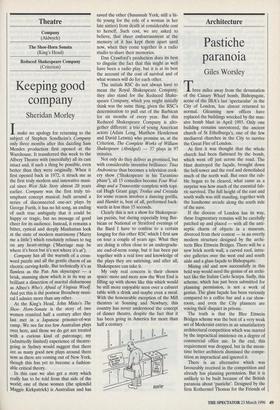Architecture
Pastiche paranoia
Giles Worsley
Three miles away from the devastation of the Canary Wharf bomb, Bishopsgate, scene of the IRA's last 'spectacular' in the City of London, has almost returned to normal. Gleaming new offices have replaced the buildings wrecked by the mas- sive bomb blast in April 1993. Only one building remains unrestored, the ancient church of St Ethelburga's, one of the few mediaeval churches in the City to survive the Great Fire of London.
At first it was thought that the whole church had been flattened by the bomb, which went off just across the road. The blast destroyed the facade, brought down the bell-tower and the roof and demolished much of the north wall. But once the rub- ble began to be cleared, what came as a surprise was how much of the essential fab- ric survived. The full height of the east and south walls was still standing, together with the handsome arcade along the south side of the nave.
If the diocese of London has its way, these fragmentary remains will be carefully patched up and placed — with all the anti- septic charm of objects in a museum, divorced from their context — in an overtly modern structure designed by the archi- tects Blee Ettwein Bridges. There will be a new brick north wall, a curved roof, intru- sive galleries over the west end and south aisle and a glass facade to Bishopsgate.
Mixing old and new successfully in this bold way would need the genius of an archi- tect like the Italian Carlo Scarpa. Sadly, this scheme, which has just been submitted for planning permission, is not a work of genius. The glass facade has been variously compared to a coffee bar and a car show- room, and even the City planners are voicing their disquiet in private.
The truth is that the Blee Ettwein Bridges scheme was the best of a very weak set of Modernist entries in an unsatisfactory architectural competition which was marred by the impractical insistence on a degree of commercial office use. In the end, this requirement was dropped, but in the mean- time better architects dismissed the compe- tition as impractical and ignored it.
There is an alternative which was favourably received in the competition and already has planning permission. But it is unlikely to be built because of the British paranoia about 'pastiche'. Designed by the firm Rothermel Thomas for the Friends of St Ethelburga's, it proposed reconstructing the church around the surviving remains.
According to the eminent structural engineers, Alan Baxter Associates, recon- structing St Ethelburga's is quite practical. It is a small, well-recorded church and the key architectural elements survive. The north wall was always plain; the roof would not be hard to replace and the façade was very simple. But to reconstruct a building in this way strikes at the heart of today's dominant conservation philosophy, that one should never try to 'fake' a building; that any new work needs to be obviously different from the old, and designed to be `of our time'. Anything else would be 'pas- tiche', evidence of the British obsession with the past.
But in our insular self-absorption, we have failed to realise that there is nothing particularly British about the desire to reconstruct historic buildings damaged in disasters. Indeed, it has been a common response of all nations in this century. After the second world war, for instance, the Russians carefully rebuilt the Imperial palaces outside Leningrad; the Poles, the whole centre of Warsaw; the Germans, the Archbishop's palace at Witrzburg; the French, the Palais de Rohan in Strasbourg; the Italians, the monastery of Monte Cassi- no. Even the British reconstructed many of the Wren churches badly damaged in the Blitz. Nor was this a temporary aberration of the post-war years. Today buildings are being reconstructed all over Europe.
Perhaps the most telling comparison with St Ethelburga's is in the north-west corner of Italy where the beautiful cathe- dral of Venzone was flattened, along with the ancient town that surrounds it, in two earthquakes in 1976. The authorities want- ed to rehouse the inhabitants in modern houses on a new site. The inhabitants resist- ed, determined to rebuild Venzone `dov'era, com'era' — where it was, as it was.
Their determination succeeded, and walking round Venzone today, one finds it hard to remember how devastating the damage was. Last year, the rebirth of the town was completed by the reconsecration of the cathedral, which had been far more badly damaged than St Ethelburga's but now stands again, its scars visible to those who can read them, but to all intents and purposes the church that stood there before.
This could still happen at St Ethelburga's. Then the work of terrorists would not be recorded through careful preservation of the damage they caused. Instead, St Ethelburga's would rise phoenix-like, a symbol of democracy's capacity to renew itself and overcome the affronts of terrorism. Then perhaps it could be given the purpose for which it is most clearly suited: a national memorial to the victims of terrorism.
Giles Worsley is editor of Perspectives on Architecture.



































































 Previous page
Previous page